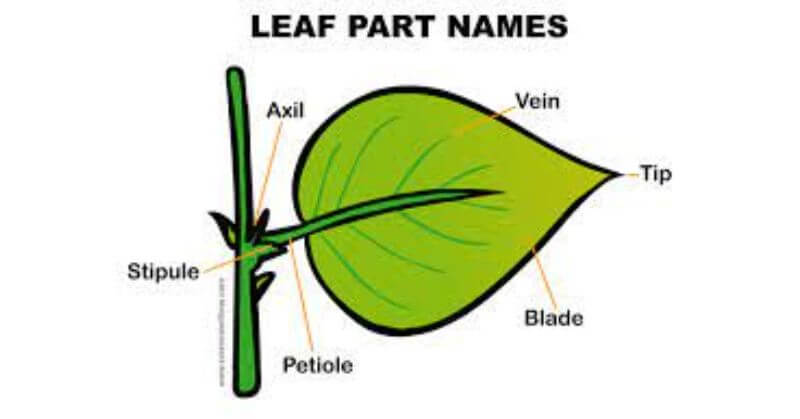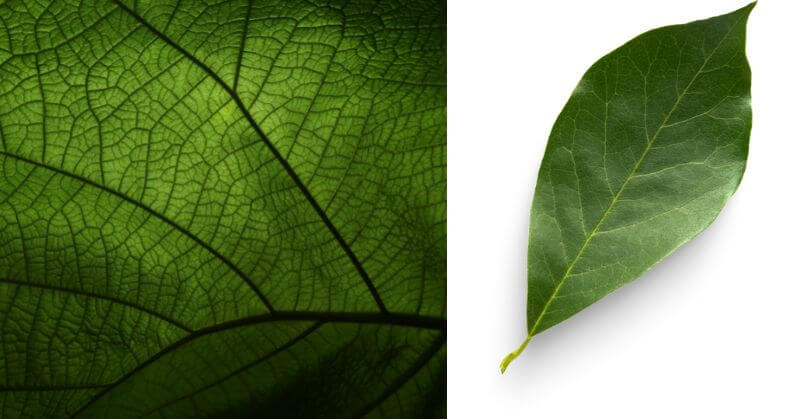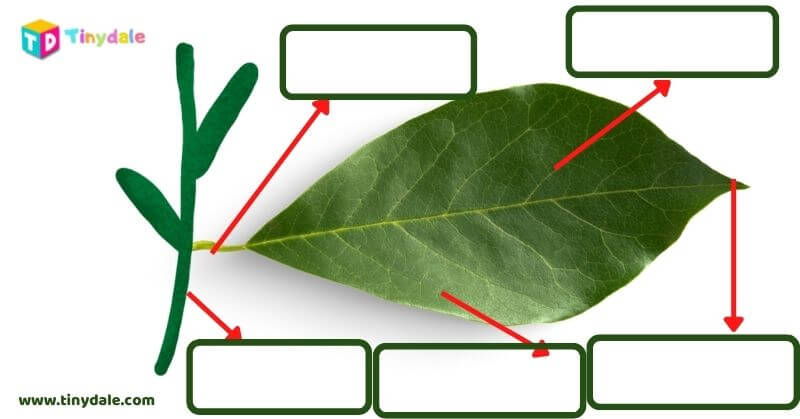Leaves come in all shapes and sizes. They grow on trees and bushes, and even on other leaves. Some leaves are green, while others are brown or yellow. The shape of a leaf depends on its age and where it grows. Leaves have many parts. In this blog post, we will learn in detail about parts of a leaf for kids lesson plans with fun activities.
Bonus: Don’t Forget to get your free copy of Free Worksheets on Parts Of a Leaf Lesson!
Discover the different types of leaves and their uses! Explore the world around you through science experiments! Have you ever wondered what does the leaf do? make sure to ask in the class to maintain curiosity.
The leaf is:
- Flat
- Thin
- Usually green in color( The presence of chlorophyll makes the leaf green which helps in preparing food in plants with the help of a process called photosynthesis). The scientific term for green leaf is foilage. Let us dive into the detail parts of a leaf and their function.

1. Stem
A stem is the main part of a leaf. It connects the leaf to the rest of the plant. The stem has two sides: an upper side called the adaxial surface and a lower side called the abaxial surface. The adaxial surface faces up toward the sun, while the abaxial surface faces away from the sun.
A petiole is a thin extension of the stem that helps support the leaf.
The widest part of the leaf is the blade. It’s usually made up of several leaflets.
Laminas are flat layers of tissue that lie between the blade and the veins.
2. Vein – Parts of a Leaf for Kids
There are three kinds of veins in leaves: midveins, marginal veins, and intermediate veins. Midveins run parallel to each other along the length of the leaf. Marginal veins connect the midveins to the edges of the leaf. Intermediate veins connect the midvein to the margin
3. Petiole
A petiole is the stalk-like part of a leaf that connects the blade (leaf) to the stem. It’s also called a rachis because it resembles a rachet.
4. Lamina – Parts of a Leaf for Kids
It is the thin part of the leaf.It is green in color. There are three main parts of a leaf: the blade, the petiole, and the stipule.
Blade: This is the largest part of the leaf and contains the veins.
Petiole: This is the stalk-like portion of the leaf that connects the blade to the stem.
Stipule: These small leaves are found at the base of the leaf blade.
Bonus: Don’t Forget to get your free copy of Free Worksheets on Parts Of a Leaf Lesson!
5. Blade
Leaf parts: A leaf has many different parts. Each part serves a purpose. Let’s take a closer look at each one.
Here you can check the leaf parts labeled and complete leaves diagram.
Summary
External parts of the leaf are as follows:
- Petiole
- leaf base
- lamina
- leaf apex
- leaf margin
Internal parts of the leaf are as follows:
- Stomata
- guard cells
- epidermal cells
- mesophyll cells
- vascular bundles (xylem, phloem, veins)
Bonus Question And Answer Session On Parts Of A Leaf For Kids
Q. What is Sessile Leaf?
A. The leaf that is attached directly to the stem without the help of petioles is called a sessile leaf.
Examples are:
- Saffron
- Achyranthus
Q. What are the parts of a leaf for kids?
A. Basically the leaf has 3 parts:
- Leaf Apex
- Leaf Margin
- Leaf Veins
Q. What are the functions of a leaf for kids?
A. The leaves are responsible for producing food for the plant with the help of the process known as photosynthesis.
Q. What are the 4 features of a leaf?
A, The 4 basic characteristics of the leaf are:
- Leaves are lateral dissimilar appendages of the stem.
- Leaves are always borne at the node of the stem.
- There is an axillary bud in the axil of a leaf. generally.
- The growth of the leaf is limited.
Q. What are the 4 types of leaves?
A. On the basis of number of leaflets the leaves are of following types:
- unifoliate – one leaflet.
- bifoliate – two leaflets.
- trifoliate – three leaflets.
- quadrifoliate – four leaflets.
- multifoliate – five or more leaflets.
Q. What are the 5 layers of a leaf?
The 5 layers of the leaf are as follows:
- cuticle layer
- upper epidermis
- palisade layer
- spongy layer
- lower epidermis and the stomata
Q. What is leaf in simple words?
A leaf is an above-ground plant organ which is generally green in color and responsible for making food for the plant.
Q. What are the five uses of leaf?
A. The 5 uses of leaves are:
- It helps to make food for the plant
- Helps to make food for us
- It helps to exchange gases
- Helps in the process of transpiration
- Leaves help in trapping sunlight.
Q. What are the 3 types of leaves?
A. The 3 types of leaves are Simple, compound and palmately leaf.
Q. Why are leaves green for kids?
A. The leaves of the plants are green because it consists of most of the chemicals which are green in color known as chlorophyll.
Q. What is a leaf for Grade 5?
A leaf is the part of the plant which is attached with the help of stem and is flat in structure.
I hope you like our question and answer round if you do don’t forget to let us know in the comment box below!
Happy Learning!
So, I hope you enjoyed learning about leaves. And this is all about leaves. This lesson plan is perfect for parts of a leaf for preschool. So, here we have come up with easy and engaging lesson plan for parts of a leaf which is very popular among primary children and is used widely. We are attaching a free Leaf template which you can use for free just don’t forget to tag us and share with your family and friends. Happy Learning!
Parts of a Leaf Worksheet For Free!
Bonus: Don’t Forget to get your free copy of Free Worksheets on Parts Of a Leaf Lesson! Here it is:
Also Read: Let us start this lesson with the top 4 ways To Teach fall lesson plans for preschool.
Follow Us: Facebook | Instagram | Twitter | Youtube | Pinterest
Tinydale is on YouTube, Click here to subscribe for the latest videos and updates.


